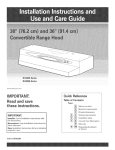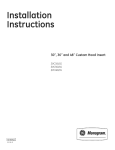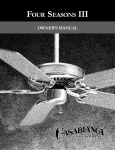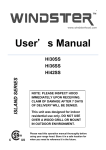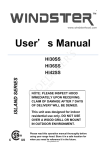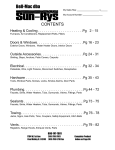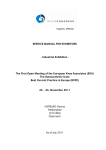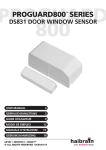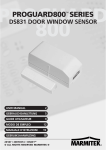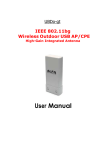Download RA-31 series - Windster Range Hoods
Transcript
WINi:JS're~TM MODEL: RA.3030/3036 RA.3130/3136 OPERATION MANUAL c@~s 230302 Please read and save this guide through before using your range hood Store the guide away in a safe place so that you will know where it is. when you want to refer to it. A. Important Safety Instructions Read and Save These Instructions CAUTION- To reduce risk of fire and to properly exhaust air. be sure to duct air outside- Do not vent exhaust air into spaces within walls or ceilings or into attics, crawl spaces, or garages. WARNING- To reduce the risk of fire or electric shock. do not use this fan with any solid- state speed control device. WARNING- To reduce the risk of fire, electric shock. or injury to persons, observe the following: A. Use this unit only in the manner intended by the manufacturer. if you have Questions. contact the manufacturer. B. Before servicing or cleaning unit. switch power off at service panel to prevent power from being switched on accidentally. CAUTION- For general ventilating use only. Do not use to exhaust hazardous or explosive materials and vapours. WARNING- To reduce the risk of a range top grease fire: A- Never leave surface units unattended at high settings. Boilover~ cause smoking and greasy spillovers that may ignite. Heat oils slowly on low or medium settings. B- Always turn hood on when cooking at high heat or when cookin~ flaming foods. C- Clean ventilating fans frequently. Grease should not be allowec to accumulate on fan. D- Use proper pan size. Always use cookware appropriate for the size of the surface element. -1- WARNING- To reduce the risk of injury to persons in the event of a range top grease fire. observe the following: A- SMOTHER FLAMES with a close- fitting lid. cookie sheet. or metal tray, then turn off the burner. Be careful to preven burns. If the flames do not go out immediately, EVACUATE AND CALL THEFIREDEPARTMENT. B- NEVER PICK UP A FLAMING PAN- You may be burned. C- DO NOT USE WATER including a violent steam explosion wet dishcloths or towels- will result. 0- USE AN EXTINGUISHER ONLY IF: 1. You know you have a CLASS ABC extinguisher, and you already know how to operate it. 2. The fire is small and contained in the area where it started. 3. The fire department is being called. 4. You can fight the fire with your back to an exit. WARNING- Sufficient air is needed for proper combustion and exhausting of gases through the flue (chimney) of fuel burning equipment to prevent back drafting. Follow the heating equipment manufacturer's guideline and safety standards such as these published by the National Fire Protection Association (NFPA),and the American Society for Heating. Refrigeration and Air Conditioning Engineers (ASHRAE), and the local code authorities. Keep the range hood clean. WARNING- To reduce the risk of fire. use only metal duct work. -2- B. Safety Notes 1. Allelectrical work must be done in accordance with local and/or national electrical code as applicable for safety. This product must be grounded if your are unfamiliar with methods of installing electrical wiring, secure the services of a qualified electrician. 2. Turn off power at service entrance before installing wiring or servicing this product. (120 volt for range hood. 220 volt for electric range if any) 3. Turn off power to avoid risk of fire, electric shock or injury to persor for cleaning or maintenance such as lubrication. 4. Fireplaces. gas furnaces. water heaters and the like require proper flow of combustion air and exhaust. Make sure this flow is not altered when using any exhaust fan. 5. Please read specification label on product for further information and requirements. 6. Please wear "Safety Gloves" for installation. cleaning, light bulb changing and dismantling to reduce the risk of any bodily injuries. CAUTION- To reduce the risk of fire and to properly exhaust air, be sure to duct air outside. 00 not vent exhaust air into spaces within walls or ceilings or into attics crawl spaces or garages. .3. c. Tools and Materials Required ~ Drill.electric of ratchet drive. with 3/16" wood bit (for drilling starter holes and 1 ¥4 "wood bit (to drill an access holes in the cabinet or kitchen wall for the electric power line) ~ One common screwdriver. ~ Plier (for opening electrical knockout). ~ Two 1" (thick)x2" (wide)x12" (approximate length) wood strips for recessed bottom kitchen cabinet installation only. (Purchase locally). ~ Electrical wire and supplies to comply with local cords. ~ Four 1 ¥4 " long flat head wood screws (purchase wood strips. locally) to mount ~ Pencil and ruler for marking locations. Saber saw or keyhole saw for cutting the 1"x2"wood strips to length. D. Ducting This style of range must be vented via ducting to the outside of the house Follow general rules when ducting the hood: Use correct size of ducting at least 6" round. do nof reduce size of ducting. make all turns gradual. no short corners. If ducting ran will be longer than 10 feet enlarge duct by at least 1" inch diameter after each 10 feet. Tape all joints in ducting and all gasketed openings on hood for a tight seal. For round ducting from the top: Fit the gray plastic (Included) over the circular opening on top in order to providea tight seal for ducting to attach to. The GRAY ring is designed to fit 6"and 7" ducting. -4- E. Preparing The Range Hood 1. Remove the top electrical knockout. you may plan to bring power to the range hood either through the cabinet or through the wall (Fig.1) ~"~I Knooko", ~~~ ~ Fig. 2. Insert a screwdriver into the knockout slot and bend the knockou back and forth. (Fig.2) You may have to use pliers to pull the loosened knockout free. (Fig.3) Fig.: Fig.2 Note: When installed. the bottom edge of your range hood should be 28" 32" above the top of the cooking surface. (Fig.4) - Fig.4 -5- F. Preparing The Installation Location Note: Please also refer P.11 "J. Making the Electrical Connection' 1. A. If you want to move the electric range to make room for working on the cabinet turn off the 220 volt power for the electric range at the service entrance. B. Before moving a gas range. shut off the gas. Note: Omit steps 2a through 2d if the hood is to be mountedon a cabinet with a flush bottom. 2. For installation onto a recessed bottom cabinet: a. Measure the space (under the cabinet between the inside front edge and inside back edge (Fig.5). With a saber. cut two 1"x2" wood filler strips (purchased locally) to fill in the bottom of the cabinet. b. Start a 1 Y4" long wood screw (purchased locally) about 3" from each end of the 1"x2" wood strips (Fig.6) c. Position the strips on the cabinet bottom and screw the strips securely to the cabinet (Fig.7) d. For a more secure installation. drill four 3/16" holes from inside the cabinet. down into the wood filler strips. Insert screws into the starter holes in cabinet and tighten screws until wood filler strips are secured under cabinet. 3. Center the hood in place beneath the cabinet and flush with the front of the cabinet. Mark the following: a. The four keyhole mounting slots for the hood. Mark these onto the bottom of the cabinet; or. if the cabinet bottom is recessed. Onto the wood strips (Fig. 7) b. The electrical knockout hole. (Fig.1) Flg.5 -6- Fig.6 4. Screw the four 1"wood screws (tor mounting the hood) into the exact center of the arrow and of the keyhole mounting slots marked on the cabinet bottom (for flush installations), or marked on the 1"x2"wood strips (tor recessed cabinet installation) (Fig.7) Do not turn the mounting screws in all the way. Allow3/8" of screw to project. so the hood can be fitted place. (The screws will be tightened later) G. Providing Electrical !! I ~ D D - ~' Fig.? Power Note: Please also refer P.11 "J. Making the Electrical Connection' 1. After turning off the proper 120 volt circuit at the service entrance. drill out the electrical power line access hole marked on the cabinet bottom or wall. Use a 1 v.. "wood bit. To operate the electric drill. use an extension cord connected to another circuit. (Fig.8) Safety Warning: Ifdrillinginto the walls. be careful not to cut existing electrical cabbies. whichwouldcreate a hazard. . 2. Fish the electrical power line through the access hole drilled in the wall or bottom of the cabinet. Attach an appropriate connector (purchased locally) to the end of the power line for the type of wiring being installed. Follow all codes.(Fig.9) Color: green/white/black Flg,9 -7- Wiring to power supply & SAFETY WARNING RISK OF ELECTRICAL SHOCK. THIS RANGE HOOD MUST BE PROPERLY GROUNDED. MAKE SURE THIS IS DONE BY SPECIALIZED ELECTRICIAN IN ACCORDANCE WITH ALL APPLICABLE NATIONAL AND LOCAL ELECTRICAL CODES. BEFORE CONNECTING WIRES, SWITCH POWER OF AT SERVICE PANEL AND LOCK SERVICE PANEL TO PREVENT POWER FROM BEING SWITCHED ON ACCIDENTALLY. Connect the electrical wires. - Connect three wires (black. white and green) to house wires and cap with wire connectors. Connect according to color: black to black. white to white. and green to green as shown on Figure A. - If necessary to hide the electrical wire connections. push wires back into the wiring box. Access the wire connections underneath the hood. Make sure wires do not slip between motor or any moving parts to prevelJt any damage. ~ .: Flgu,e.A~"~ , "0 ~ . ,,~ . ",J ~ ~ !. ;. : ..; : : . I. _.. . ..'--.'- "') -8- .! . <::1 H. Mounting Range Hood To Cabinet Note: Please also refer P.11 "J. Making the Electrical Connection' 1. Position the hood in place so that: a. The electrical line is routed through the appropriate opening. This step will have to be accomplished the hood (Fig.1 0) Knockout while positioning b. The large part of the keyhole mounting slots on the hood fit onto the hood mounting screws projecting from the bottom of the cabinet. (Fig.11) 2. Adjust the hood so the front is flush with the cabinet front. 3. Tighten the hood mounting screws all the way into the cabinet or into the 1" x 2" wood strips so the hood is secure. Color: green/white/black ""'~, Fig.10 -9- _~ '1-_ I Fig.1 I. Mounting Range Hood Without Cabinet Note: Please also refer P.10 "J. Making the Electrical Connection' 1. Using metal brackets and screws (included), center hood onto board and install screw. 2. Remove the hood from the board and nail the wood board onto the wall. (Be sure the nail is in the center of the stud) 3. Place the range hood on the board and tighten the screw. 4. Complete finished 5. Duct cover (Optional) (refer P.15 and P.17) -10- J. Making the Electrical Connection 1. Turn the six nuts at the front/back of bottom board. ( Fig.13) 2. Remove screws on wiring case. fish out wires through the knockout. (Fig.13) screw Fig.! 3. Mark the electrical connection by fastening all wires to the existing wall wiring according to the their colors. (Black to Black, White to White. Green to Ground) 4. After connection is done, reinstall wiring case cover and bottom board. 5. Slide plastic collection cups onto the back metal mounting. 6. Turn on power and check operation of fan and light. -11- K. Use and Care .... ABC Operate switches (Fig.9) Switch A: "ON" I e I I . - When the hood is "OFF", turn on the blower by press" button once the blower will operate at second speed and - During operation, contiune to press" blower "Delay" 0 I Fig.9 ON I OFF I DELAY light indicate "2", "OFF" I . . LED "button twice, the will stop, the LED light and halogen light will also turn off. - While the blower is in operation, . press" "button once, it will set the blower to turn off within 30 seconds auto mafically, and the LED light" Switch B: "is flashing until the blower stops, 181 Light switch - While the blower is in press". Switch C : I (It I "button. operation or not. turn the halogen light by Once press again to turn halogen light off. Blower Control While the hood is operation press" fa "button once the blower will be rotated from 3 -) 2 -) 1 -) 2 -) 3 by circulation and the LED light". as well. Switch D: 181 "will be indicated the speed by 3 -) 2 -) 1 -) 2 -> : LED Indicator - To indicate the blower speed at 3,2 or 1. - Delay flash on or off. -12- L. Halogen light replacement Note: The halogen light will be very hot when it is working bare hand(s). Before changing Never touch it with halogen light ensure the unit is switched off and the halogen light is cool. ~q B Q Note: Ensure the unit is switched off. Before changing lamp. A. Using suitable tool (small screw driver) gently pry off the lamp cover lenz. B. Remove the unserviceable serviceable Lamp. Replace the removed lamp with new lamp, taking note not to touch the glass lamp surfacE with your bare fingers. (Use a suitable cloth). C. Replace the lenz cap and reconnect WARNING: the power and test lamp. To reduce the risk of a range top grease fire. A. Never leave surface units unattended at high settings. Boilovers cause smoking and greasy spillovers that may ignite. Heat oils slowly on low or medium settings. B. Always turn hood on when cooking at high heat or when cooking flaming foods. C. Clean ventilating fans frequently. accumulate on fan. Grease should not be allowed to D. Use proper pan size. Always use cookware size of the surface element. -13- appropriate for the M. Maintenance Instruction 1. Maintenance shall be important than repair. Please take care of the needed maintenance functions in order to secure and extend the excellent and using life. Note: Before repairing the range hood. Disconnect the power source. 2. After using the machine. wipes the machine by neutral detergent in order to keep it clean and maintain the appearance with brightness and sanitation. 3. When the level of dirty oil of the collector be removed in order to avoid overflowing N. Simple Trouble Shooting reached 4/5 of height, it has t( and pollution. Rules Correction Symptom 1. Checkpowersourceto see if . it is normal Both fans are not operatable i 2. Check power inlet plug to see if it is plugged firmly into it's socket 1. Disconnect Illuminating indicator gives no light 2. Check lamp bulb. replace it with a new one if it is burned lamp out (20 watts 12V) i i Hood vibrates ---- the power source i 1. Check for damaged vanes 2. Check if exhaust duct is secured -14- o. Parts Layout Diagram 15 ~~ 1 2 3 4 5 6 I Machine body Controlswitch Halogenlight Transformer Capacitor Capacitorbracket 7 8 9 10 11 12 Chamber Motor Fan Oiltunnel Bottomboard Oilcollector(oval) -15- 13 14 15 16 17 18 Safetymesh Oilcollector(round) Hangingbracket Innerductcoyer(optional) Outerductcoyer(optional) Ductcoyer-mounting bracke P. Circuit Diagram NOTE: Any faults with this unit should only be attended to by a qualifiec technician. G)§@@ -16- Q. Size o Model: RA-3030 / RA-3036 o Model: RA-3130 / RA-3136 / RA-3142 / RA-314E -17-



















